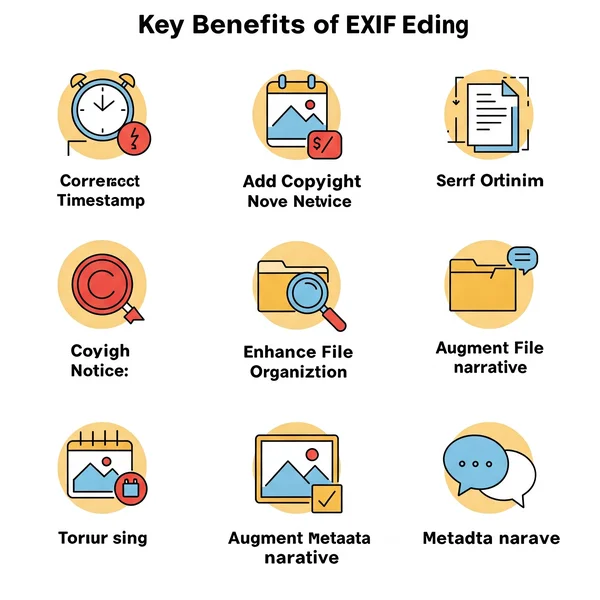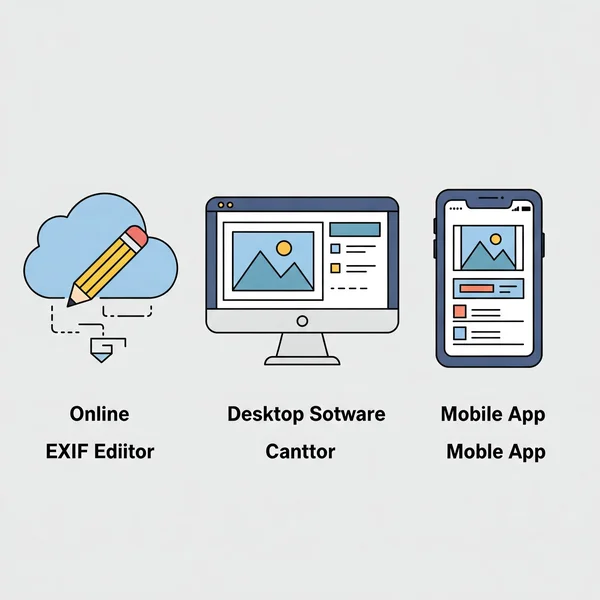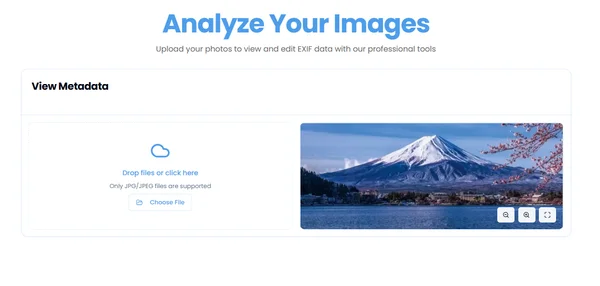EXIF Data Editing: Correct & Enhance Photo Information
Beyond just viewing or removing, did you know you can actually edit metadata within your photos? For photographers and meticulous image organizers, EXIF data editing offers a powerful way to correct inaccuracies, add crucial information, and truly take control of your image files. How to edit EXIF data? This guide will walk you through the process, exploring why you'd want to change EXIF data and how an EXIF data editor can become an indispensable tool in your metadata management toolkit. Explore advanced EXIF tools on our platform to get started.
Why Edit EXIF Data? Benefits for Photographers & Professionals
While viewing EXIF data provides insight and removing it enhances privacy, editing opens up a new level of control. Consider these photo editing tips focused on metadata:
Correcting Inaccurate Information
Sometimes, your camera's clock might be off, or a GPS location might be slightly inaccurate. An EXIF data editor allows you to correct photo timestamp details or fine-tune location data, ensuring your records are precise.
Adding Copyright and Ownership Details
This is crucial for professionals. You can add copyright to photo EXIF, embed your name as the author, and include usage rights information directly within the image file, helping to protect your intellectual property.
Enhancing Photo Organization and Searchability
Effective metadata management involves adding descriptive keywords, captions, and ratings to your photos. This makes it significantly easier to search and organize large photo libraries.
Providing Context and Storytelling
Use an EXIF data editor to add notes, comments, or even a story behind the shot. This can be invaluable for personal archives or for providing richer context when sharing images.

What EXIF Data Can You Typically Edit?
The range of editable EXIF fields is extensive. While not every tag can or should be altered, common fields you can edit metadata for include:
- Date and Time: Original, Digitized
- GPS Information: Latitude, Longitude, Altitude (use with caution)
- Camera Information: Make, Model (often best left untouched unless for specific corrections)
- Image Orientation
- Author/Artist
- Copyright Notice
- Image Description/Caption
- User Comment
- Keywords/Tags
- Rating
Knowing what you can change EXIF data for helps you plan your metadata management strategy.
Choosing Your EXIF Data Editor: Tools of the Trade
Several types of EXIF data editor tools are available, each with its strengths:
Online EXIF Editors
Web-based tools offer convenience, allowing you to edit metadata without software installation. They are great for quick edits on a few files. Many platforms, including our online EXIF editor, provide robust capabilities.
Desktop Software with Editing Capabilities
These often provide more comprehensive features, including batch editing for efficient metadata management of large collections. Examples include ExifToolGUI (a graphical front-end for the powerful ExifTool), Adobe Bridge, and Lightroom.
Mobile Apps for On-the-Go Edits
Some mobile apps also offer EXIF editing functionalities, perfect for making quick changes directly from your smartphone.

How to Edit EXIF Data: A Step-by-Step Guide
The exact steps to edit metadata will vary depending on the specific EXIF data editor you use. Here’s a general approach, with a focus on how an online tool like ours works.
Using an Online EXIF Data Editor (e.g., on our EXIF management site)
Our platform for EXIF solutions offers a user-friendly way to edit EXIF data online. The process is straightforward:
- Upload Your Photo: Navigate to our editor section and upload the image you wish to modify.
- Access the Editable Fields: Our tool will display the various EXIF tags, with editable fields clearly marked.
- Make Your Changes: Click on a field (e.g., "Date Time Original," "Copyright") and input your new information.
- Save/Download the Modified Photo: After making all desired changes, apply them and download the photo with the updated EXIF data.
This process allows you to easily change EXIF data without needing complex software.

Editing EXIF Data with Desktop Software (e.g., ExifToolGUI)
- Open the Image: Launch the software and load your photo.
- Navigate to Metadata/Info Panel: Find the section that displays EXIF tags. Most dedicated editors make these easily accessible.
- Modify Specific Tags: Select the tag you want to edit metadata for (e.g., "Artist," "UserComment") and enter the new value.
- Apply and Save Changes: Click a "Save" or "Apply" button. Some tools save directly to the original (so have a backup!), while others prompt you to save a new copy.
Best Practices for EXIF Data Editing
When you modify photo metadata, keep these photo editing tips and metadata management best practices in mind:
Always Keep a Backup of Original Files
Before making any changes, especially if the software edits the original file directly, ensure you have a backup. This protects you from accidental data loss or incorrect edits.
Be Accurate and Consistent
Ensure the information you add or change is correct. If you're implementing a metadata management system for a large library, maintain consistency in how you apply keywords and descriptions.
Understand the Implications of Changing Certain Data
Altering core data like the "Date Time Original" can impact the perceived authenticity of a photo. Be mindful of why you're making such changes.
Respect Copyright and Privacy
Never use an EXIF data editor to falsely claim copyright over someone else's work or to add misleading GPS information.
Common EXIF Editing Scenarios & Solutions
Here are some common reasons people want to edit metadata and how an EXIF data editor helps:
Correcting Wrong Photo Timestamps
If your camera clock was incorrect, you can easily correct photo timestamp information to reflect the actual capture time.
Adding or Updating Copyright Information
A vital step for professionals: use an EXIF data editor to add copyright to photo EXIF fields like "Artist" and "CopyrightNotice."
Batch Editing EXIF Data for Multiple Photos
For large photo sets, tools that support batch edit metadata (often desktop software) can save a significant amount of time. You can apply the same copyright, author, or keywords to hundreds of images at once.

Removing Unwanted GPS Data
While the previous article focused on removal for privacy, sometimes you might want to change EXIF data for GPS by removing overly precise coordinates and replacing them with a general city or region, or correcting a slightly off GPS tag.
Your Questions on Editing EXIF Data Answered
Can I edit EXIF data on my smartphone?
Yes, there are mobile apps available for both iOS and Android that allow you to edit metadata. The range of editable fields might be more limited compared to desktop EXIF data editor software, but they are convenient for quick changes.
What is the free EXIF data editor?
"Best" is subjective and depends on your needs. ExifTool (command-line) is incredibly powerful and free. For a graphical interface, ExifToolGUI is a popular free option. Some free image viewers/organizers also have basic EXIF editing capabilities. If you prefer not to install software, an online exif editor tool can be an excellent choice.
Will editing EXIF data damage my photo?
No, properly using an EXIF data editor to edit metadata will not damage the visual part of your photo. EXIF data is stored separately from the image pixel data. However, always work on copies if you're unsure about a tool.
How do I add my name to a photo's EXIF data?
You can use an EXIF data editor to add your name to fields like "Artist," "Author," or "Creator" and your copyright information to the "CopyrightNotice" field. This is a key part of metadata management for professionals.
Taking Full Control of Your Photo Metadata
EXIF data editing empowers you to go beyond just viewing or deleting information. By learning how to edit EXIF data, you can ensure accuracy, protect your rights, enhance organization, and add valuable context to your images. Whether you're correcting a timestamp, adding your copyright, or managing a vast photo library, the right EXIF data editor is key. We encourage you to explore these capabilities and see how refined metadata management can elevate your photography workflow. If you're looking for tools to help, consider checking out the resources available on our comprehensive EXIF platform.